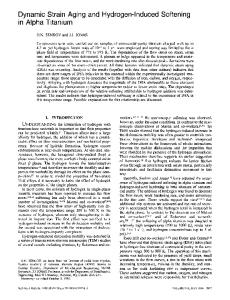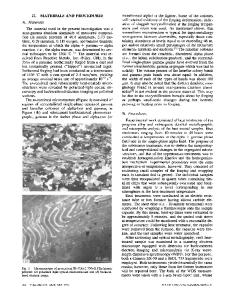Mechanism of shear band formation and dynamic softening in a two-phase (α 2 + γ) titanium aluminide
- PDF / 1,824,163 Bytes
- 12 Pages / 584.957 x 782.986 pts Page_size
- 114 Downloads / 898 Views
FOCUS ISSUE
INTERACTIONS OF SHEAR TRANSFORMATION BANDS
Mechanism of shear band formation and dynamic softening in a two-phase (a2 + c) titanium aluminide Nitish Bibhanshu1,a)
Satyam Suwas1,b)
1
Department of Materials Engineering, Indian Institute of Science, Bangalore 560012, India Address all correspondence to these authors. e-mail: [email protected] b) e-mail: [email protected] a)
Received: 30 December 2019; accepted: 3 April 2020
The formation of shear bands during hot deformation of a two-phase (a2 + c) titanium aluminide and its consequences on dynamics softening has been investigated. The starting material consists of a colony of lamellar grains along with the segregated vanadium and niobium which was subjected to hot deformation in the temperature range 1000–1175 °C at the strain rate 10 s−1. Microstructures of the deformed samples indicate that, with increase in the deformation temperature, the orientation of shear bands changes. Moreover, the extent of dynamic recrystallization also increases with deformation temperature. The softening behaviour and crystallographic orientation change within lamellae during hot deformation have been explored. The nucleation of newly recrystallized grains has been observed at twin–parent grain boundary and within the twined c phase. Lamellae of the c and a2 phase have been also observed to be twisted and tilted, leading to the band formations under the load, whose mechanisms have also been explored in the present study.
Introduction
in these materials, are quite complex. Under such circum-
For the past few decades, great efforts are undertaken to develop novel intermetallic c-titanium aluminide (c-TiAl)– based alloys [1, 2, 3, 4]. These alloys possess low density (;3.8 g/cm3), good corrosion, and oxidation resistance along with outstanding mechanical properties, such as a high specific strength and Young’s modulus [5, 6, 7]. These unique prop-
stances, large deformations lead to the formation of shear
erties make these materials amenable for the replacement of relatively heavier nickel-base alloys and steels [8, 9, 10]. At present, titanium aluminides are used in the low-pressure regime of gas turbine [11, 12]. Because of poor ductility of the c phase, lower aluminiumcontaining titanium aluminide alloys are developed that possess two phases, namely, the a2 and c phases. The crystallographic structure of the c and a2 phases are L10 and D019, respectively [13]. The microstructure of the two-phase alloys in the as-cast condition consists of lamellar features with maintained orientation relationship between the two phases [14]. In addition to a2–c lamellae, a lamellar c–c structure is also observed, which occurs due to twin relationships [15]. Because of the low symmetry and ordered structure of both the phases, dislocation activity and twining, which render plasticity
ª Materials Research Society 2020
bands [16], especially for deformation at lower temperatures. Moreover, c titanium aluminides generally form very strong solidification texture and coarse colo
Data Loading...











